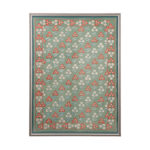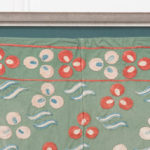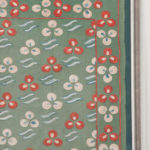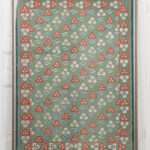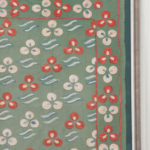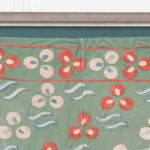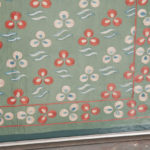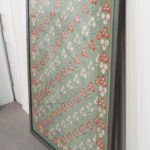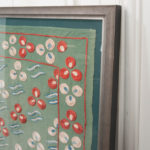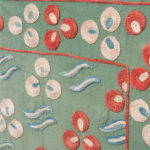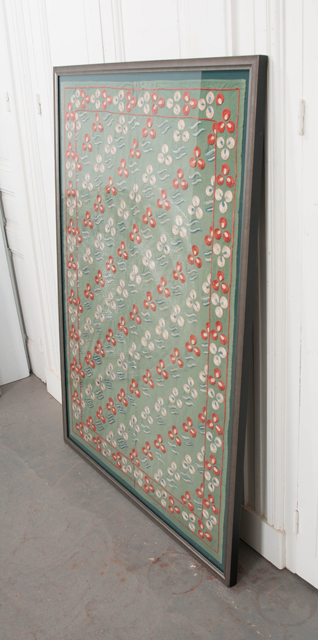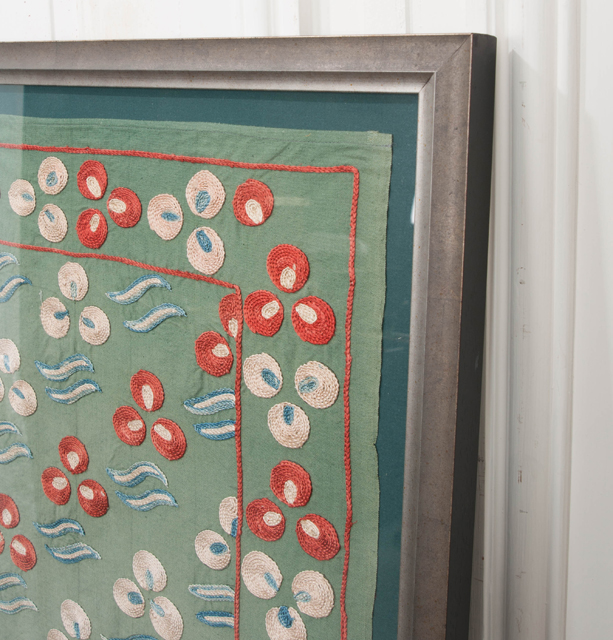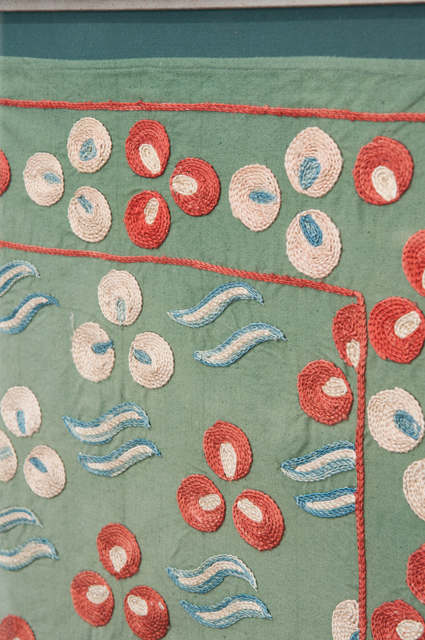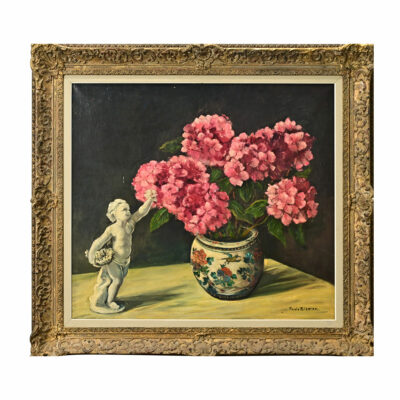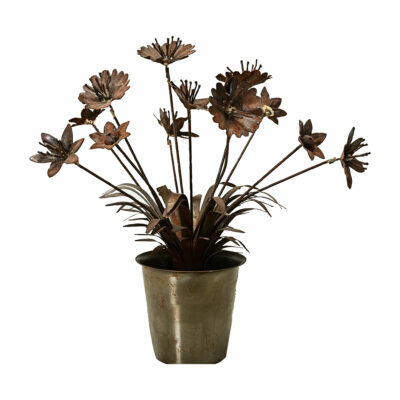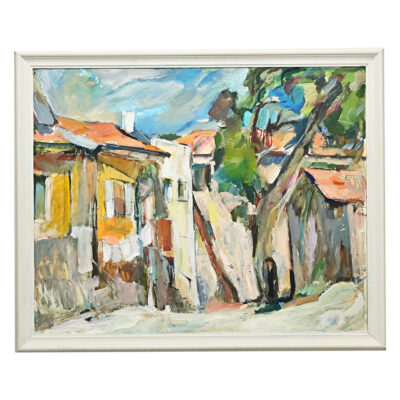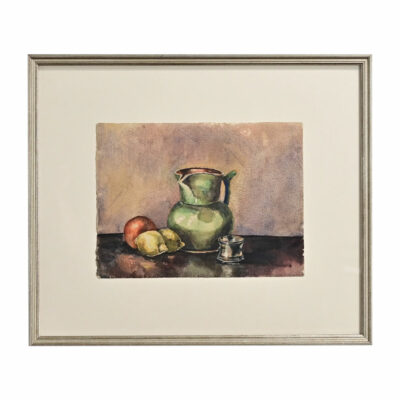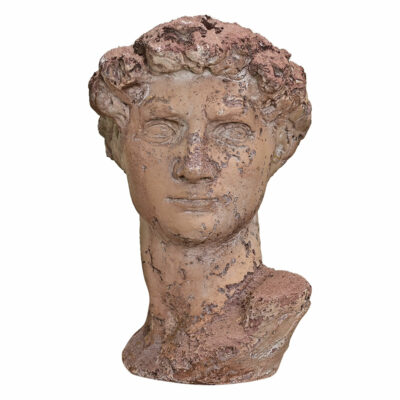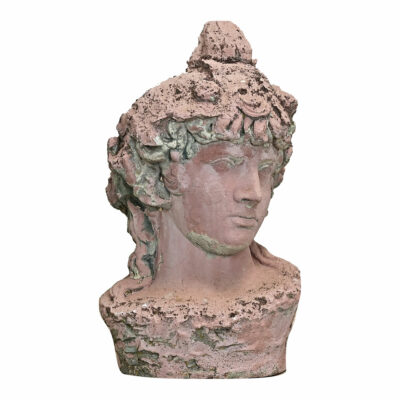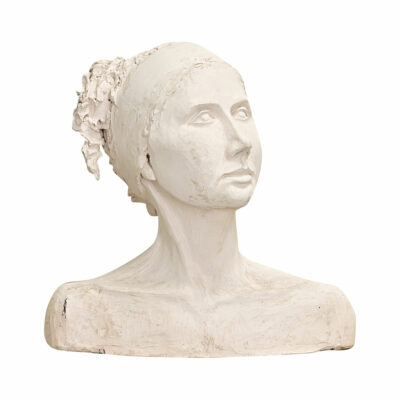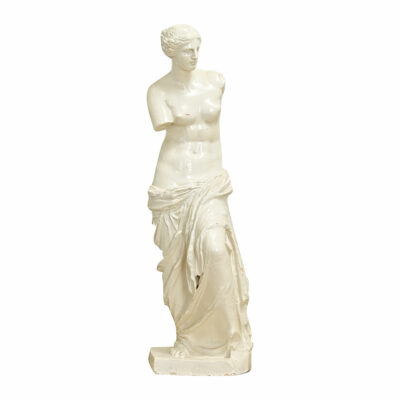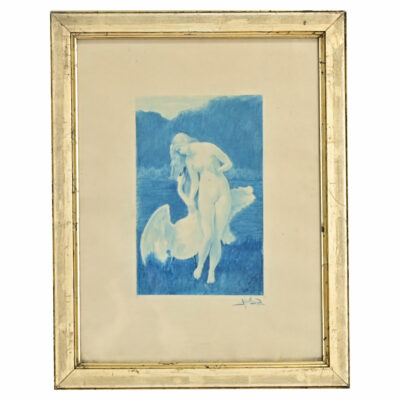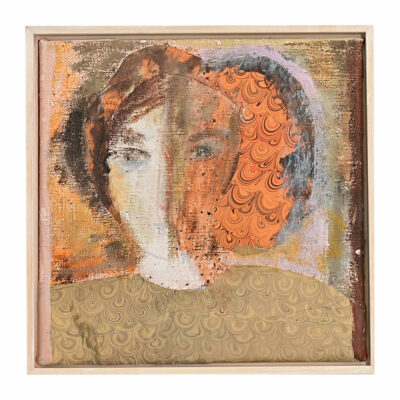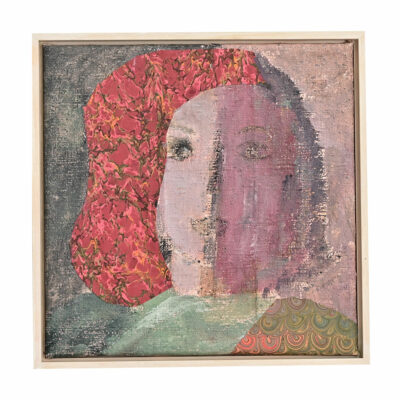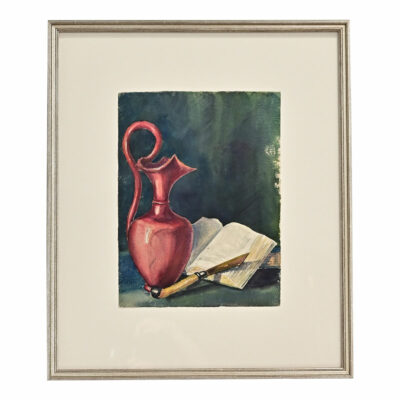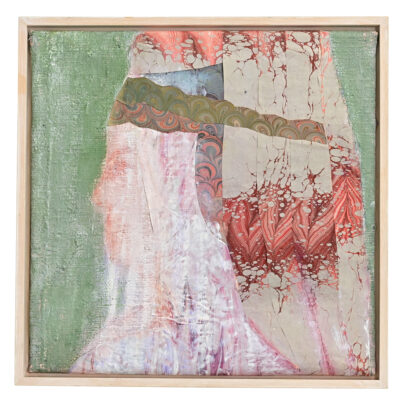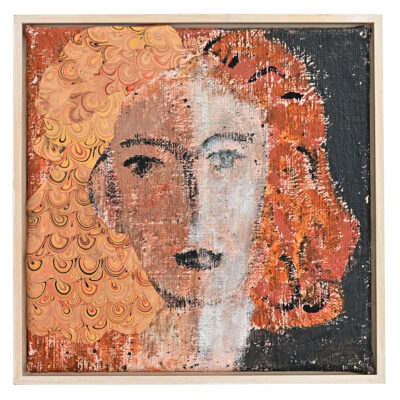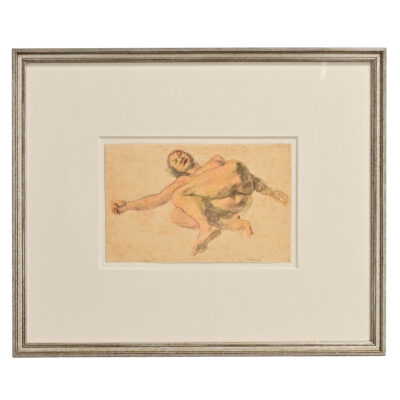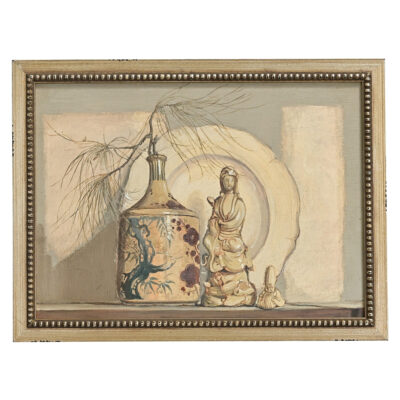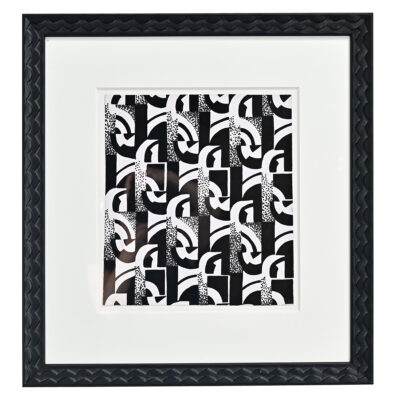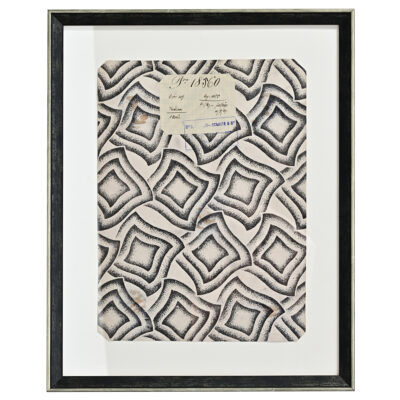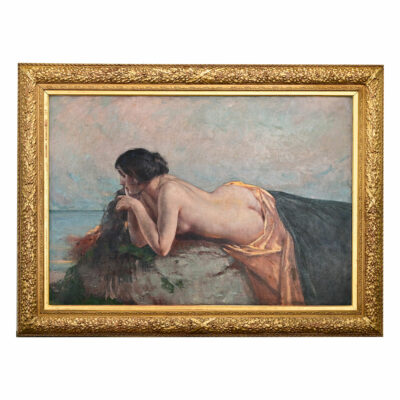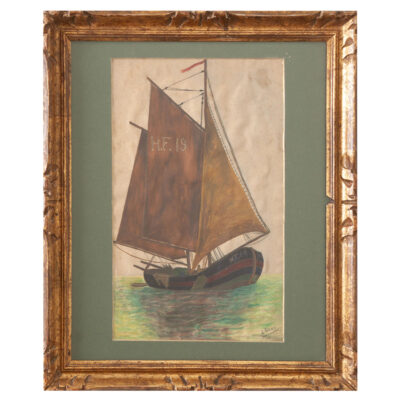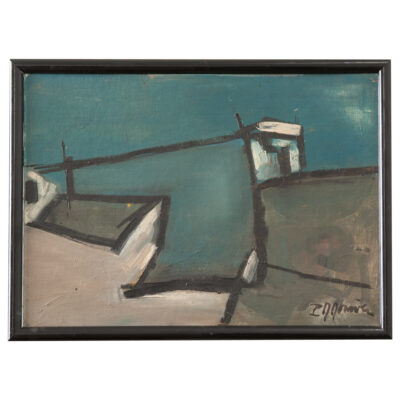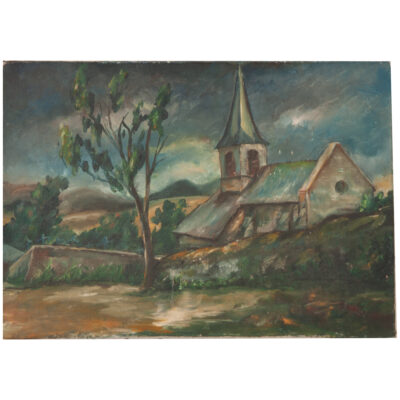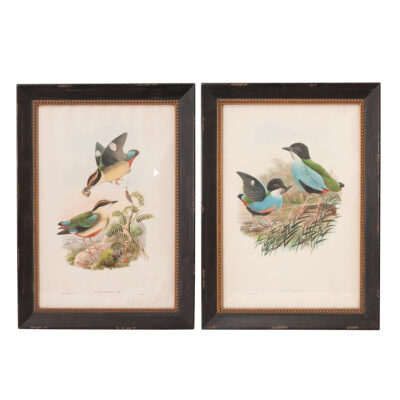Rare Vintage “Nim Suzani” Embroidered Textile Panel
$2,100.00
SKU: AN0830
Dimension: 56.5"H x 42.13"W x 1"D
Dimensions: 56-1/2”H x 42-1/8”W x 1”D
A rare, vintage “Nim Suzani” hand-embroidered textile panel, in a “flower-and-wave” pattern, from Uzbekistan, c. 1920’s, mounted on a forest-green mat, behind glass, and presented in a silvered wooden frame. The ground is a lightweight cotton-and-silk blend, known as adras, which was colored using natural dye resulting in this rare shade of mellow green. The flowers and waves were created using a chain stitch throughout with a naturally dyed embroidery thread made of silk and perhaps a little bit of cotton for added strength. This example has a hand-stitched seam down the center likely indicating two women worked on this piece. In the Persian language, “Nim” translates to “small pattern” and “Suzani” means “needlework.” Uzbek women, working alone, with other women, or in guilds, produced elaborate embroidered tapestries, bed linens, table linens, and prayer mats for their households and their daughters’ dowries. The Suzani pattern was almost lost during the Russian occupation of Central Asia, but, when the Soviet Era ended Westerners became more familiar with these fine Uzbek pieces and new markets for these old forms and techniques developed. This textile would add a handcrafted touch of warmth and color to a den or living room, library, or kitchen beautifully!
Out of stock
Looking for something similar?
- Size Guide
BUY WITH CONFIDENCE
Fireside Antiques is committed to ensuring that you are satisfied and at peace of mind with each purchase you make. Our team is dedicated to making your shopping experience enjoyable.
YOUR PERSONAL SALES CONSULTANT
Fireside Antiques has a team of expert sales consultants who are knowledgeable in the industry and ready to assist customers, answer questions, and provide advice on acquisitions.AUTHENTICITY GUARANTEE
Fireside Antiques provides an authenticity guarantee for its products, which means it guarantees that they are genuine. We hand select our inventory in Europe and do not purchase locally.PROFESSIONAL PACKING & SHIPPING
Fireside Antiques can quote to have your purchases professionally packaged by local packaging companies. All white glove shippers are required to inspect, photograph and personally blanket wrap your antiques.RETURNS & EXCHANGES
Fireside Antiques allows customers to return purchases for a full refund as long as they are in the same condition as when received, but the customer is responsible for the cost of shipping both ways. No returns after 7 days.PAYMENT OPTIONS
Fireside Antiques offers multiple payment options, including credit cards, checks and cash.YOUR PRIVACY & SECURE ONLINE TRANSACTIONS
At Fireside Antiques, we prioritize the privacy of our customers and the security of their transactions, whether online or in-person. We keep all purchases discreet and do not share any customer information with third parties. - Delivery & Return
Shipping & Return
ORDER CONFIRMATION
You will receive a confirmation email from us after you place your order. A staff member will review your order the next business day and contact you about shipping, delivery or pickup. If you do not receive a confirmation within one business day (excluding Sundays), please contact us.PICKUP
Items are available for pickup Mon - Sat 10am - 5pm. Or by appointment. Please contact us at least 24 hours in advance to have your items ready for pickup. If you want to pick up your merchandise, please select this option at the time of purchase as local or state sales tax may apply. It is also recommended to contact our showroom to confirm its availability and readiness for pickup, especially for larger items.DELIVERY
Delivery is limited to the Greater Baton Rouge and surrounding areas in the state of Louisiana. For specific delivery information, please contact our showroom at 225.752.9565. Delivery prices may vary and there are geographical limits to where our trucks can deliver, so it is important to clarify this before proceeding.SHIPPING
If you don't have a preferred shipping company, Fireside Antiques maintains a list of professional transporters that serve North America & Internationally.- If you need help selecting a shipper, we will need necessary information for your transport. Contact name, phone number, address and any specific details such as; timelines for delivery, stairs, etc.
- After we receive this information, we will reach out to one of our trusted shippers that serve your area and provide you with quotes and the shipper's contact information. You can then choose to use this shipper or select one of your own. Fireside Antiques does not receive any compensation from shippers, and each shipper is required to insure and take full responsibility for your merchandise after picking it up from our premises. Shipping is paid directly from the client to the shipper.
- Once you have chosen a shipper, we will then coordinate with your chosen shipper for pickup at our premises. After the item is picked up, the best source of information about the actual delivery of your merchandise will be your selected shipper.
RETURNS
Fireside Antiques customer satisfaction is our top priority. If you are not satisfied with your purchase, you can return it within 7 days of delivery for a full refund of the item cost. This is only if the item is in the original condition as it left our premises. Please note that customers are responsible for the shipping cost. Once we receive and inspect the returned items, we will process a refund to the original payment method (e.g. credit card, bank account) used for the transaction.- No returns or exchanges will be accepted after 7 days.
- Refunds will not be issued until merchandise has been received.
- We are not responsible for any shipping charges paid to third parties.
- Ask a Question
About
Dimensions: 56-1/2”H x 42-1/8”W x 1”D
A rare, vintage “Nim Suzani” hand-embroidered textile panel, in a “flower-and-wave” pattern, from Uzbekistan, c. 1920’s, mounted on a forest-green mat, behind glass, and presented in a silvered wooden frame. The ground is a lightweight cotton-and-silk blend, known as adras, which was colored using natural dye resulting in this rare shade of mellow green. The flowers and waves were created using a chain stitch throughout with a naturally dyed embroidery thread made of silk and perhaps a little bit of cotton for added strength. This example has a hand-stitched seam down the center likely indicating two women worked on this piece. In the Persian language, “Nim” translates to “small pattern” and “Suzani” means “needlework.” Uzbek women, working alone, with other women, or in guilds, produced elaborate embroidered tapestries, bed linens, table linens, and prayer mats for their households and their daughters’ dowries. The Suzani pattern was almost lost during the Russian occupation of Central Asia, but, when the Soviet Era ended Westerners became more familiar with these fine Uzbek pieces and new markets for these old forms and techniques developed. This textile would add a handcrafted touch of warmth and color to a den or living room, library, or kitchen beautifully!
Details
Additional information
| Dimensions | 1 × 42.13 × 56.5 in |
|---|
Related Products
Framed Painting by Belgium Artist Paule Bisman
$3,200.0037.50"H x 93.75"W x 15"D
Dimensions: 37 ½” H x 93 ¾” W x 15” D
A large scale whimsical still life painting signed by the Belgium artist, Paule Bisman. The oil painting is on canvas and is framed by a complimentary carved and gilt frame. Be sure to view the detailed images to get a closer look of its current condition.
French Vintage Metal Pot of Flowers
$225.009.50"H x 10.50"W x 10.50"D
Dimensions: 9 ½” H x 10 ½” W x 10 ½” D
A vintage metal pot of flowers made in France. Made from thin brass and formed into flowers, the lightweight medium allows for some movement of the tall stems and sits in a rounded base. Be sure to view the detailed images for the current condition.
Modern Painting by Anna Khodorovsky Lipkind
$3,800.0035.50"H x 43.25"W x 1.50"D
Dimensions: 35 ½” H x 43 ¼” W x 1 ½” D
A colorful abstract painting by Anna Khodorovsky Lipkind, a Jewish artist in Mea Shearim, Jerusalem. This modern painting is oil on canvas framed in a white painted frame. Be sure to view the detailed images to see the current condition.
Watercolor Still Life, Framed
$595.0020.75"H x 24.50"W x 1"D
Dimensions: 20 ¾” H x 24 ½” W x 1” D
A vintage still life painting, watercolor on paper. This painting has recently been matted and framed in a silver finished frame. New conservation grade UV protective glass. Be sure to view the detailed images.
Reconstituted Stone Sculpture of a Man
$850.0014.50"H x 11"W x 8"D
Dimensions: 14 ½” H x 11” W x 8” D
A European bust of a man made of stained reconstituted stone. Impressive craftsmanship and details are found throughout. Be sure to view the detailed images to see every angle.
Reconstituted Stone Sculpture of a Lady
$850.0017.50"H x 10.25"W x 5.25"D
Dimensions: 17 ½” H x 10 ¼” W x 5 ¼” D
A European bust of a lady made of stained reconstituted stone. Impressive craftsmanship and details are found throughout. Be sure to view the detailed images to see every angle.
Vintage Plaster Statue of a Lady
$2,100.0017.88"H x 18.50"W x 10"D
Dimensions: 17 ⅞” H x 18 ½” W x 10” D
A life-like scale and replica of a lady. Impressive craftsmanship and details can be found on this bust made of plaster. Be sure to view all the details from every angle.
Petite Replica Statue of Venus de Milo
$795.0033.50"H x 9.50"W x 12"D
Dimensions: 33 ½” H x 9 ½” W x 12” D
This petite replica of the iconic statue, Venus de Milo, is just under three feet tall. The original statue was found on the island of Milos, and is believed to be the Greek goddess, Aphrodite, referred to in Roman mythology as Venus. This reproduction is made of plaster and is smaller than its original copy, now seen at the Louvre Museum, in Paris, France. Be sure to view the detailed images to see the current condition of this Venus de Milo statue.
Antique Drawing of Leda & The Swan
$925.0022.50"H x 17.75"W x 1"D
Dimensions: 22 ½” H x 17 ¾” W x 1” D
An antique pencil on paper drawing of Greek Goddess Leda being seduced by Zeus in the guise of a swan. The antique gilt frame is in wonderful antique condition and houses antique glass. Be sure to view the detailed images.
Mixed Media Painting of a Lady Face
$985.0017.25"H x 17.25"W x 1.50"D
Dimensions: 17 ¼” H x 17 ¼” W x 1 ½” D
A recently made painting of a lady by an unknown Dutch artist. The mixed media collection of materials on canvas depicts a lady’s face and is framed in a simple wood frame. Be sure to view the detailed images.
Mixed Media Painting of a Lady Face
$985.0017.25"H x 17.25"W x 1.50"D
Dimensions: 17 ¼” H x 17 ¼” W x 1 ½” D
A recently made painting of a lady by an unknown Dutch artist. The mixed media collection of materials on canvas depicts a lady’s face and is framed in a simple wood frame. Be sure to view the detailed images.
Watercolor Still Life, Framed
$595.0025"H x 21"W x 1"D
Dimensions: 25” H x 21” W x 1” D
A vintage still life painting, watercolor on paper. This painting has recently been matted and framed in a silver finished frame. New conservation grade UV protective glass. Be sure to view the detailed images.
Watercolor Still Life, Framed
$595.0020.75"H x 24.50"W x 1"D
Dimensions: 20 ¾” H x 24 ½” W x 1” D
A vintage still life painting, watercolor on paper. This painting has recently been matted and framed in a silver finished frame. New conservation grade UV protective glass. Be sure to view the detailed images.
Dutch Mixed Media Lady
$985.0017.25"H x 17.25"W x 1.50"D
Dimensions: 17 ¼” H x 17 ¼” W x 1 ½” D
A recently made painting of a lady by an unknown Dutch artist. The mixed media collection of materials on canvas depicts a lady’s face and is framed in a simple wood frame. Be sure to view the detailed images.
Dutch Mixed Media Lady
$985.0017.25"H x 17.25"W x 1.50"D
Dimensions: 17 ¼” H x 17 ¼” W x 1 ½” D
A recently made painting of a lady by an unknown Dutch artist. The mixed media collection of materials on canvas depicts a lady’s face and is framed in a simple wood frame. Be sure to view the detailed images.
French Framed Painting of a Lady
$625.0016.75"H x 20.25"W x 1"D
Dimensions: 16 ¾” H x 20 ¼” W x 1” D
A petite vintage watercolor painting on paper of a nude lady. Recently framed with a matboard, silvered finish frame and new protective glass. This painting is ready to be hung in your interior. Be sure to view the detailed images.
English Framed Still Life Painting by Gaskell
$535.0012"H x 15.75"W x 1.25"D
Dimensions: 12” H x 15 ¾” W x 1 ¼” D
A petite framed still life painting by English artist, William John Clare Gaskell. This oil on canvas still life painting is whimsical and fun. Surrounded by a decorative wooden frame with a silvered finish this painting is ready to be hung in your interior. Be sure to view the detailed images to see the current condition.
English Handmade Wallpaper Sample, Framed
$815.0021.50"H x 20.25"W x 1"D
Dimensions: 21 ½” H x 20 ¼” W x 1” D
An original wallpaper strike off from England in the 1930’s has recently been framed. The new frame is carved and scalloped in an ebonized finish and new protective glass. The mat board is shaped to compliment the wallpaper. This mix of modern and antiquity compliment each other well. Be sure to view the detailed images for a closer look at all the details.
English Handmade Wallpaper Sample, Framed
$695.0018.25"H x 23"W x 1.25"D
Dimensions: 18 ¼” H x 23” W x 1 ¼” D
An original wallpaper strike off from England in the 1930’s has recently been framed. The new frame is angular and ebonized with a silver gilt trim and new protective glass. The mat board is shaped to compliment the wallpaper. This mix of modern and antiquity compliment each other well. Be sure to view the detailed images for a closer look at all the details.
Gerard Roosens “Girl On A Beach”
$16,995.0051.25"H x 69.25"W x 3"D
Dimensions: 51 ¼” H x 69 ¼” W x 3” D
A large scale framed painting by Belgian Artist, Gerard Roosens 1869 – 1935. Entitled “Girl on a Beach” is signed by the artist. The oil painting is on canvas and is surrounded by a museum quality carved and gold gilt frame. Be sure to view the detailed images to get a closer look of its current condition.
French Framed Painting of a Ship
$420.0021.13"H x 18.13"W x 1.13"D
Dimensions: 21 ⅛” H x 18 ⅛” W x 1 ⅛” D
A gold gilt framed watercolor painting on paper of a ship at sea. The painting is scripted “HF. 19” and is signed by the artist. Be sure to view the detailed images, it is ready to be hung in your interior.
French Framed Abstract Painting
$525.0014.38"H x 19.38"W x 0.88"D
Dimensions: 14 ⅜” H x 19 ⅜” W x ⅞” D
A framed French abstract painting, signed by the artist. The use of muted hues perfectly compliments the black frame. Be sure to view the detailed images to see the current condition of this painting.
Vintage Painting of a Church
$325.0013"H x 18.25"W x 0.88"D
Dimensions: 13” H x 18 ¼” W x ⅞” D
A landscape painting on canvas depicting a night time scene of a church. No signature found. Be sure to view the detailed images to see the current condition of this vintage artwork.
French Pair of Reproduction Framed Lithographs
$2,650.0025.50"H x 18.50"W x 1.50"D
Dimensions: 25 ½” H x 18 ½” W x 1 ½” D
A vibrant pair of reproduction colored lithographs made in France depicting two “pitta steerei” or azure-breasted pitta birds. The lithographs have script reading “J. Gerald & W. Hart del et. lith.” and “Walter imp.”. Framed and ready to hang in your interior. Be sure to view the detailed images.


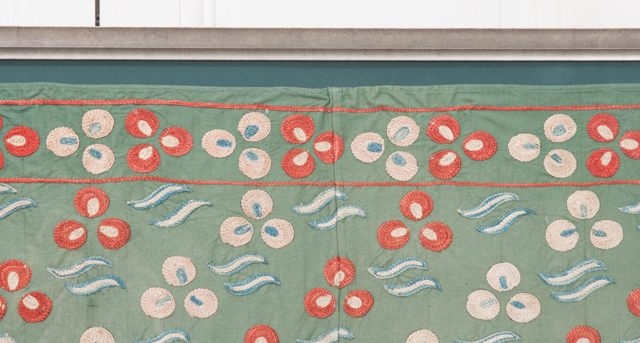
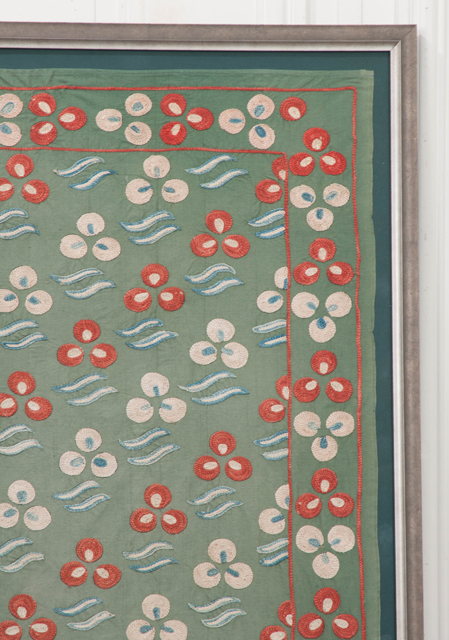
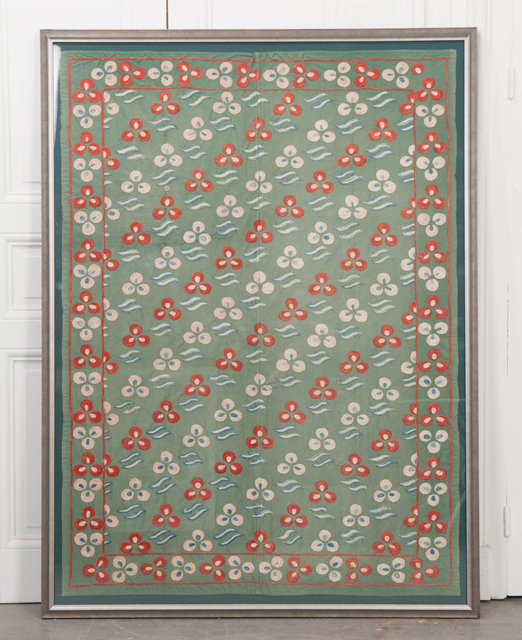
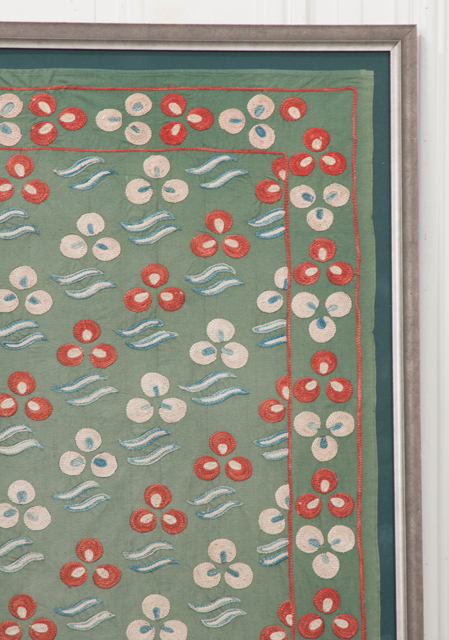
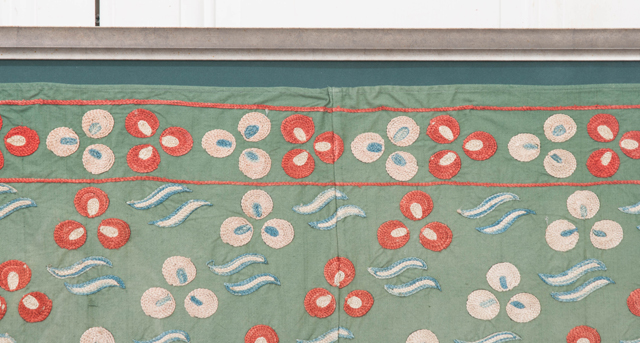
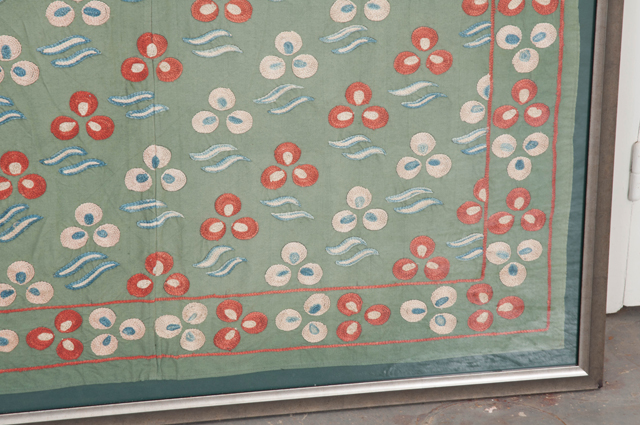
Rare Vintage “Nim Suzani” Embroidered Textile Panel
Dimensions: 56-1/2”H x 42-1/8”W x 1”D
A rare, vintage “Nim Suzani” hand-embroidered textile panel, in a “flower-and-wave” pattern, from Uzbekistan, c. 1920’s, mounted on a forest-green mat, behind glass, and presented in a silvered wooden frame. The ground is a lightweight cotton-and-silk blend, known as adras, which was colored using natural dye resulting in this rare shade of mellow green. The flowers and waves were created using a chain stitch throughout with a naturally dyed embroidery thread made of silk and perhaps a little bit of cotton for added strength. This example has a hand-stitched seam down the center likely indicating two women worked on this piece. In the Persian language, “Nim” translates to “small pattern” and “Suzani” means “needlework.” Uzbek women, working alone, with other women, or in guilds, produced elaborate embroidered tapestries, bed linens, table linens, and prayer mats for their households and their daughters’ dowries. The Suzani pattern was almost lost during the Russian occupation of Central Asia, but, when the Soviet Era ended Westerners became more familiar with these fine Uzbek pieces and new markets for these old forms and techniques developed. This textile would add a handcrafted touch of warmth and color to a den or living room, library, or kitchen beautifully!

